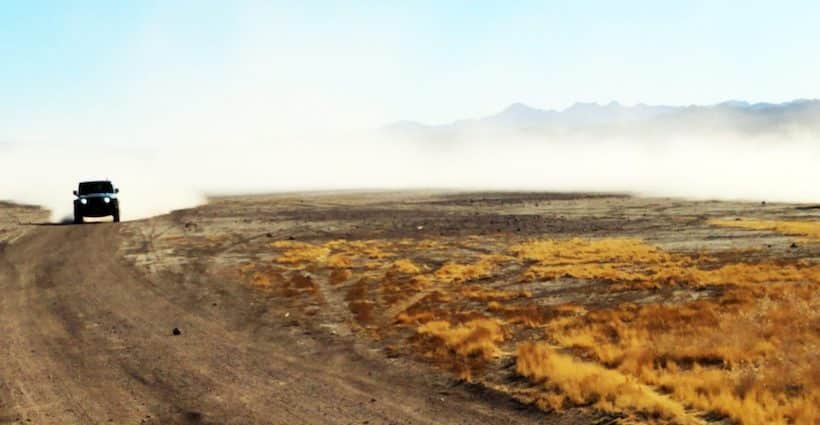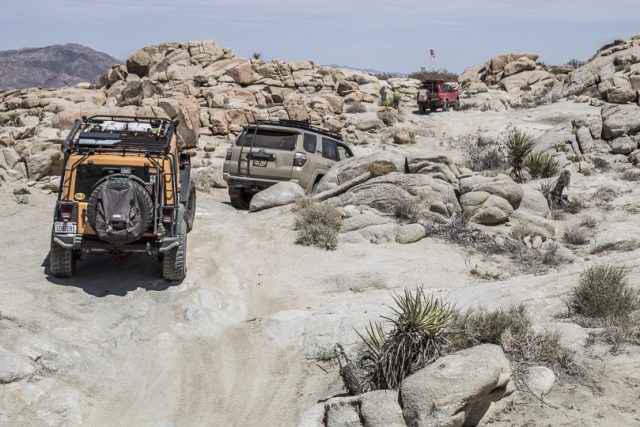You’ve been four-wheeling for some time now. Probably drove a few challenging trails and endured a weekend in ugly weather. Perhaps you participated in one of my excursions (or someone else’s) and thought, “I’d like to be a Trail Guide.”
That’s great. While the position entails a fair amount of responsibility, it’s a good way to more fully experience four-wheeling. And to give back to the hobby by teaching others.
Trail Guides (also called Trail Leaders) are skilled individuals who are willing to share their passion, knowledge, skills and respect for the outdoors with others. Some outfitter guides use horses and pack mules. We use 4WD vehicles.
To become a Trail Guide requires both skill and personality: the right mix of tangible and intangible characteristics to lead a group of four-wheelers on a trip that could be challenging and memorable.
It starts by being a student while on the trails. Observe how another Trail Guide leads their excursions. Scrutinize their actions, and decide how you might handle the same situations. Take notes throughout the day as you encounter the different situations.
Ask pointed questions along the way. Learn the various nuances needed to master each trail. Help fellow drivers through their challenges.

Benefits of being a Trail Guide:
The Trail Guide is a very rewarding position. Here is what you can expect.
- Satisfaction from teaching a respect for the environment and the outdoors, and living an outdoor-centric ethic.
- Satisfaction of providing perhaps a once-in-a-lifetime experience to someone who might not otherwise get the chance.
- Providing lessons in history and geology.
- Setting the agenda and timetable, and generally doing it your way.
- Receiving accolades and fame for a successful run. This can be fleeting but might get you nominated for the next Trail Guide job!
- Being in front, out of the dust.
Challenges of being a Trail Guide:
The Trail Guide is also a challenging position. Make note of these.
- In a word, responsibility. You are responsible for ensuring a safe and – to the extent possible – enjoyable trip. A pretty heavy load, if you think about it.
- With responsibility comes pressure to make sure all goes well. That means you don’t get lost, the vehicles come out reasonably intact, and there are no major conflicts. Stress varies with the group size, your relationship to the group (friends, club, large organization), trail difficulty, and your familiarity with the trail. Even with a small group of friends on a well-known trail, you will experience some stress. The stress is much greater on a distant trail you had no opportunity to scout in advance.
- You are constantly on alert. You cannot relax and merely follow the vehicle in front. Know where you are at all times and how to reach designated locations like the trailhead or campsite.
- You must exude confidence at all times. Even when concerned, try not to show it.
- Lots of homework before the trip. It’s your responsibility to map out and scout the trail when possible. You need to determine the last place to gas up, and when and where the group will meet. You also need to decide on campsites, hotels, and a host of other details.
- Grumbling and dissatisfaction after a poor run. Dissatisfaction can come from myriad causes. Poor management of time and not sticking to schedules without easily understood reasons will get you poor marks. So will being a “road monger.” That’s someone who pushes too hard to meet a timetable and cajoles people to get going or staying up with the pack.

Specific skills a good Trail Guide needs:
A Trail Guide should have certain skills. These include:
4WD Skills: To become a Trail Guide, you must first be an experienced driver. Experience builds your confidence – and it shows. The ability to read the terrain and pick successful lines is at the top of the list. As the lead vehicle, you do not have the benefit of watching vehicles ahead of you negotiate the obstacle. Except for very difficult situations, you’re likely to attempt the obstacle without a spotter.
A good Trail Guide is also a good teacher. He coaches drivers through tough spots. On some days, you’ll have to spot an entire group through difficult terrain. Observe how different vehicles behave. Of primary concern are wheel base, transmission type (manual, automatic) and suspension (coil springs, leaf springs, articulation).
Your vehicle must be built to a level beyond that required for the trail. Know its capabilities and limitations.

Scouting and Planning Skills: A successful ride is the result of planning and preparation along with the skills you bring. Scout the trail(s), and plan the trip thoroughly. Yes, you must do your homework.
An adventure with unexpected difficulties can still be viewed as highly successful. After all, difficulties create teamwork, camaraderie, and stories to be told.
Plan for contingencies but go with the flow. Despite your best effort, you cannot control the weather. An unseasonal cold spell or a rainstorm can make a huge difference in comfort and road conditions.
Assume there will be breakdowns. Some vehicles aren’t maintained well. But even properly maintained vehicles can suffer a breakdown. Brush up on mechanical skills, and pack tools and spare parts.
Be prepared. Have a backup campsite. Know the location of the parts store in the nearest town. Carry a spare sleeping bag for the unprepared guest. These and other contingencies can mean the difference between continuing with a trip and aborting it.

Leadership skills: The Trail Guide is the leader and the manager for the entire trip. This person sets the tone and style for the duration. You need management skills to design, plan, delegate, motivate and make decisions. You need leadership skills to communicate, establish a vision, establish trust, and generate confidence.
The leadership tools and techniques you employ will be influenced by the makeup of the group and type of trip you are leading.
Here are three situations that will influence your leadership style:
- Leading a 4WD club may require you to specify some extra rules and be more insistent. One rule could be, “No one is allowed to pass the trail leader.” Many clubs return to the same trails year after year; members know them well. You may find it difficult to maintain control of this group. On the positive side, you can count on their knowledge and experience when help is needed.
- An Adventure / Expedition of eight to 10 days or more can require significantly more emphasis on certain skills. The planning requirements are higher and scouting in advance may be prohibitive. Fewer details of the trip are known and contingency planning will be more generic. Your leadership can really be tested by adverse weather, poor campsite choices, poor fuel management, and vehicle maintenance issues.
- Professional guiding – meaning you are paid – places new demands on you. Expectations will be higher. Driver experience and vehicle equipment will vary. This group is more likely to defer to your leadership, allowing for quicker decision making. However, some guests may need personal attention. You’ll have to budget your time accordingly.

Communication Skills: This takes many forms. The more people on the trip, the more time you will spend communicating with them. Communication is your primary tool for management and leadership. Communication includes written information (emails, texts, documents), verbal (tailgate meetings, campfire exchanges) and two-way radio transmissions.
Customer Skills: You are providing a service. Everyone who participates on your guided trip is a customer – yes, a customer. It makes no difference whether they pay for the service or not. Adopt a customer-focused mindset.
Bottom line: Be customer-focused. Let the customers’ safety, comfort, and success guide your decisions and behavior. You make better decisions when you view the group as customers (or guests).
Additional Skills: Knowing basic first aid is helpful. Four-wheeling is generally a safe hobby. But minor bumps, scratches, stings and burns can occur. Remember to always pack a first-aid kit.
Basic mechanical skills are also crucial. Your vehicle or someone else’s could suffer a breakdown. Your guests will look to you for leadership on resolving that issue.
Becoming a Trail Guide is a noble goal. While not for everyone, four-wheelers who obtain that status find it very rewarding. For me, being a Trail Guide is the apex of four-wheeling. If you’re inclined, commit the necessary time and effort. That’ll be a worthwhile new year’s resolution.

Check out 10 duties of a 4WD Tail End
___________________________________________________________















